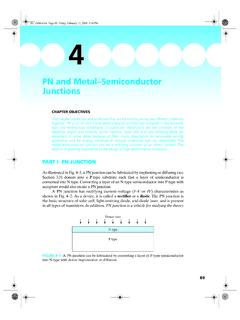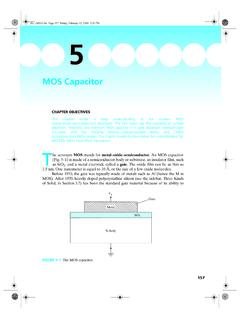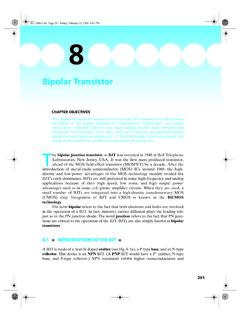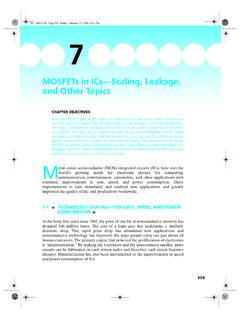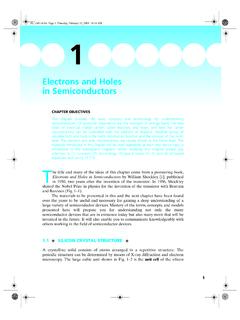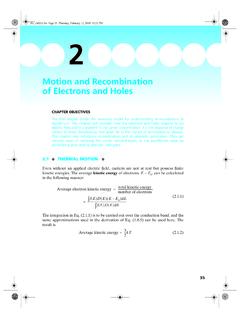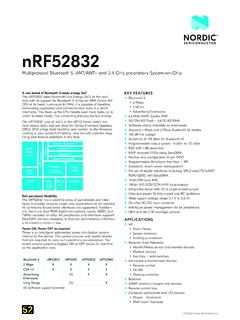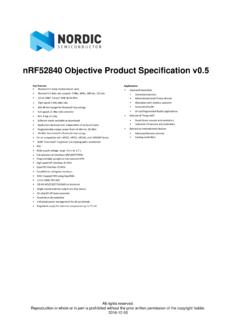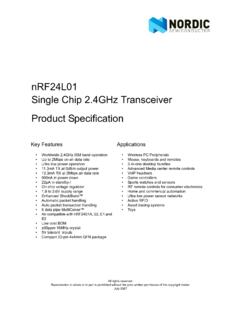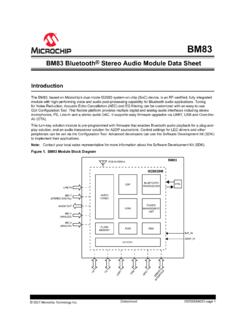Transcription of MOS Transistor - Chenming Hu
1 1956 MOS TransistorCHAPTER OBJECTIVESThis chapter provides a comprehensive introduction to the modern MOSFETs in their onstate. (The off state theory is the subject of the next chapter.) It covers the topics ofsurface mobility, body effect, a simple IV theory, and a more complete theory applicableto both long- and short-channel MOSFETs. It introduces the general concept of CMOS circuit speed and power consumption, voltage gain, high-frequency operation, andtopics important to analog circuit designs such as voltage gain and noise. The chapterends with discussions of DRAM, SRAM, and flash nonvolatile memory MOSFET is by far the most prevalent semiconductor device in ICs.
2 It isthe basic building block of digital, analog, and memory circuits. Its small sizeallows the making of inexpensive and dense circuits such as giga-bit (Gb)memory chips. Its low power and high speed make possible chips for gigahertz(GHz) computer processors and radio-frequency (RF) cellular phones. TO THE MOSFET Figure 6 1 shows the basic structure of a MOSFET. The two PN junctions are thesource and the drain that supplies the electrons or holes to the Transistor and drainsthem away respectively. The name field-effect Transistor or FET refers to the fact thatthe gate turns the Transistor (inversion layer) on and off with an electric field throughthe oxide.
3 A Transistor is a device that presents a high input resistance to the signalsource, drawing little input power, and a low resistance to the output circuit, capable ofsupplying a large current to drive the circuit load. The hatched regions in Fig. 6 1a arethe shallow-trench-isolation oxide region. The silicon surfaces under the thick isolationoxide have very high threshold voltages and prevent current flows between the N+(and P+) diffusion regions along inadvertent surface inversion paths in an IC 6 1 also shows the MOSFET IV characteristics. Depending on the gatevoltage, the MOSFET can be off (conducting only a very small off-state leakagecurrent, Ioff) or on (conducting a large on-state current, Ion).
4 Page 195 Friday, February 13, 2009 4:51 PM196 Chapter 6 MOS TransistorAt the most basic level, a MOSFET may be thought of as an on off switch asshown in Fig. 6 2(b). The gate voltage determines whether a current flows betweenthe drain and source or not. The circuit symbol shown in Fig. 6 2a connotes themuch more complex characteristics of the 6 1(a) Basic MOSFET structure and (b) IV characteristics. FIGURE 6 2 Two ways of representing a MOSFET: (a) a circuit symbol and (b) as an Semiconductor bodyN N IonVg VVg 0 Ioff(a) (b) (b) Switch representationDrainGateSource(a)Circuit symbolDrainGateSource Early Patents on the FET The Transistor and IC technologies owe their success mainly to the effort andingenuity of a large number of technologists since the mid-1900s.
5 Two early FETpatents are excerpted here. These earliest patents are presented for historical interestonly. Many more conceptual and engineering innovations and efforts were requiredto make MOSFETs what they are E. Lilienfeld s 1930 patent is considered the first teaching of the FET. InFig. 6 3, 10 is a glass substrate while 13 is the gate electrode (in today s terminology)and consists of an .. aluminum . 11 and 12 are metal contacts to the source anddrain. 15 is a thin film of semiconductor (copper sulfide). Lilienfeld taught the follow-ing novel method of making a small (short) gate, the modern photolithography tech-nique being yet unavailable to him.
6 The glass substrate is broken into two Page 196 Friday, February 13, 2009 4:51 Introduction to the MOSFET197and then reassembled (glued back) with a thin aluminum foil inserted between the twopieces. The edge of the Al foil is used as the gate. The semiconductor film is depositedover the glass substrate and the gate, and source and drain contacts are provided. Thereis no oxide between the gate electrode and the semiconductor. The insulator in this FETwould be the depletion layer at the metal semiconductor junction (see Section ). FIGURE 6 3 A perspective view, on a greatly enlarged scale and partly in section, of the novelapparatus as embodied by way of example in an amplifier.
7 (From [1].)In a 1935 British patent, Oskar Heil gave a lucid description of a to Fig. 6 4, 1 and 2 are metal electrodes between which is a thin layer 3 ofsemiconductor. A battery 4 sends a current through the thin layer of semiconductorand this current is measured by the ammeter 5. If, now, an electrode 6 in electro-staticassociation with the layer 3 is charged positively or negatively in relation to the saidlayer 3, the electrical resistance of this layer is found to vary and the current strengthas measured by the ammeter 5 also to vary. FIGURE 6 4 This 1935 drawing is a good illustration of a MOSFET even by today s standards.
8 (From [2].)1115171615151412162722101813 Page 197 Friday, February 13, 2009 4:51 PM198 Chapter 6 MOS MOS (CMOS) TECHNOLOGY Modern MOSFET technology has advanced continually since its beginning in the1950s. Figure 6 5 is a transmission electron microscope view of a part of aMOSFET. It shows the poly-Si gate and the single -crystalline Si body with visibleindividual Si atoms and a nm amorphous SiO2 film between them. nm is thesize of four SiO2 basic steps of fabricating the MOSFET shown in Fig. 6 1 is to first makeshallow-trench-isolation by etching a trench that defines the boundary of thetransistor and filling the trench with chemical vapor deposition (CVD) oxide (seeSection ).
9 Next, planarize the wafer with CMP (see Section ), grow a thinlayer of oxide (gate oxide) over the exposed silicon surface, deposit a layer ofpolycrystalline silicon as the gate material (Section ), use optical lithography topattern a piece of photoresist, and use the photoresist as a mask to etch the poly-Sito define the gate in Fig. 6 1 (Section ). Finally, implant As into the source anddrain (Section ). The implantation is masked by the gate on one side and thetrench isolation on the other. Rapid thermal annealing (see text box in Section )is applied to activate the dopant and repair the implantation damage to the can then be made to the source, drain, and the 6 6a is an N-channel MOSFET, or N-MOSFET or simply NFET.
10 It iscalled N-channel because the conduction channel ( , the inversion layer) is elec-tron rich or N-type as shown in Fig. 6 6b. Figure 6 6c and d illustrate a P-channelMOSFET, or P-MOSFET, or PFET. In both cases, Vg and Vd swing between 0 Vand Vdd, the power-supply voltage. The body of an NFET is connected to the low-est voltage in the circuit, 0 V, as shown in (b). Consequently, the PN junctions arealways reverse-biased or unbiased and do not conduct forward diode Vg is equal to Vdd as shown in (b), an inversion layer is present and theFIGURE 6 5 Gate oxides as thin as nm can be manufactured reproducibly.
